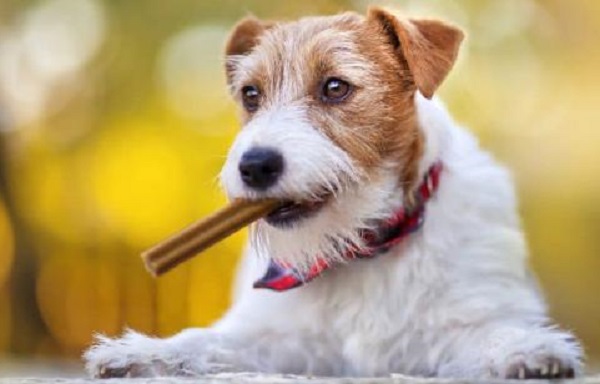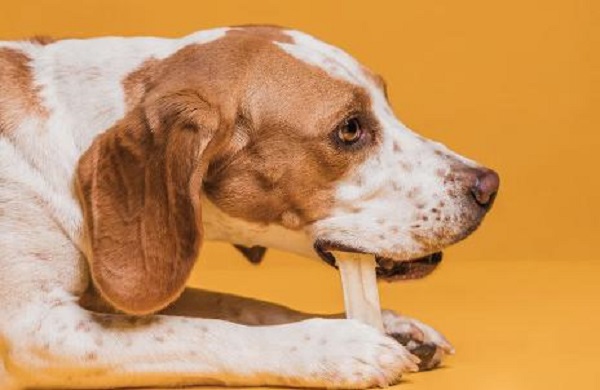Choosing Safe Edible Chews for Your Dog is covered in this brief tutorial. Finding the perfect chew for your dog is important, as you may know if you’ve ever had to deal with a chewed-up shoe or noticed your pet’s passion of biting. Chewing relieves boredom and anxiety while also strengthening jaw muscles and relieving teething pain. We’ll explore the realm of dog chews in this guide, emphasizing safety to empower you to choose wisely for your furry friend. Let’s make sure that safe and fun chews go hand in hand with those tail-wagging moments.

Recognize the Chewing Style of Your Dog
Recognizing and understanding your dog’s chewing habits is essential to guaranteeing their happiness and safety. Similar to us, dogs too have unique chewing habits and preferences.
Take into account things like breed characteristics; for example, a Boxer could chew more firmly than a Shih Tzu. Remember to pay attention to your dog’s favorite chew texture as well; some dogs may like softer chews, while others may prefer firmer ones. Given that your dog’s tastes may vary with age, it’s critical to modify your chew selection accordingly. For an elderly dog that has dental issues, a favorite chew from their adolescence may become too difficult.
Remember that every dog is different when it comes to safety. Even if a treat is listed as edible, it may not be suitable for your pet. There might be major concerns, such as choking or digestive problems, if your dog breaks off huge portions and swallows them whole. When giving your dog new chews, always keep an eye on them to make sure they suit their chewing preferences and are suitable for their particular requirements. Your dog may have a safe and fulfilling chewing experience if you acknowledge and accommodate their individual preferences.
How to Choose an Edible Dog Chew

To guarantee your dog’s safety and happiness while choosing an edible dog chew, take into account the following factors:
- Hardness: Steer clear of too hard chews since they may cause your dog’s teeth to fracture or his gums to be cut.
- Durability: To avoid your dog breaking off pieces of your chew, which might be harmful to their health, choose a chew that can resist rough chewing. Conversely, stay away from chews that are very tender.
- Sturdy: Seek for dog chews that are delicious and well-known for their longevity. These products provide additional value in addition to keeping your dog busy for longer periods of time.
- Size: To reduce the chance of choking, choose chews that are the right size for your dog. Make sure the piece of chewing is big enough to keep your dog from putting it all in their mouth at once.
- Materials: Give preference to chews made mostly of natural materials. Avoid those that have extra coatings or flavorings as they could make your dog sick.
Consult your veterinarian for advice if you have any doubts about the edible dog chews you have chosen. Based on the unique requirements and medical concerns of your dog, your veterinarian may provide tailored guidance. By considering these aspects, you can choose the ideal edible dog chew that will enhance your pet’s happiness and overall health.
Dog Chew Types That Are Edible
Below, you’ll find a list of commonly chosen chews.
Tendons and Other Zombie Components
When it comes to dog chews that are edible, tendon and other animal parts have emerged as popular options. These alternatives, which are becoming more and more well-liked while being seen as unusual, provide a distinctive take on classic selections like pig ears. For example, tendon offers a safer option because of its high protein and collagen composition and reduced fat content.
Examining tendons and other animal parts for dog chews exposes pet owners to a wide variety of possibilities. These options not only satisfy the tastes of individuals looking for unusual rewards, but they also help provide dogs with a healthy chewing experience. Always put your dog’s health and safety first while choosing from this assortment of unusual and popular edible dog chews.
Edible Bones Man-Made
Dogs may have access to a range of artificial edible bones, often known as dental bones. The purpose of these chews is to help your dog’s teeth become cleaner. Choose a highly digestible choice made of natural components, and make sure the size and form match the measurements of your dog. Make sure the dental bone you choose is both readily digested for your dog and appropriate for maintaining oral health.
Unprocessed leather
Dogs often like to chew on unprocessed leather, which is made from the inner layer of horse or cowhide. Its safety, nevertheless, varies from dog to dog. Severe chewers run the danger of splintering off big chunks, which might cause a choking or intestinal obstruction. Furthermore, raw leather is difficult to digest, which raises the possibility of blockage. To protect your dog, while giving this chew, take away any large pieces as soon as they’ve been bitten down to a size where they can’t be ingested whole.
Antlers
Natural and robust dog chews, antlers come in a range of sizes and forms and are obtained from animals like as deer and elk. The hardness of antlers may cause hazards, such as scratches to the gums and damaged teeth, even if they last a long time. The main worry is that the splintered pieces might pierce the dog’s mouth, throat, or intestines and get trapped there, necessitating immediate surgery. Even though some vets advise against having antlers, careful monitoring is necessary to reduce any possible risks while antlers are being chewed on.
Which Dog Chews Are the Best?

The ideal dog chew varies depending on a number of criteria; there is no one-size-fits-all answer. Non-edible chew toys may be the safest option for dogs that are overweight or who have sensitive stomachs. You may need to try a variety of chews before deciding on the best one if your dog is healthy yet picky. Dogs that are generally healthy and less picky about what they eat may like a variety of chews, but it’s important to make sure that no treat or chew accounts for more than 10% of your dog’s total diet. Make decisions based on your dog’s unique requirements and preferences to provide a healthy and pleasurable chewing experience.
Dog Treats You Should Avoid
To protect your dog’s safety, avoid the following dog treats since they may be dangerous:
- Hard plastic or nylon chews that are indigestible: Chews composed of these materials may not break down properly, causing obstructions un the digestive tract or discomfort. They often have sharp edges that may cause cuts and damage to teeth because they are overly hard.
- Chews that are too hard: If a chew looks too difficult for your dog to handle or bite off, it’s probably too hard for them. As a general guideline, stay away from chewing anything that would hurt if you dropped it on your knee. Extremely hard chews may cause dental fractures or other oral injuries.
- Antlers, bones, and hooves of animals: Because they are indigestible and hard, animal parts, particularly roasted bones, pose a danger to your dog’s teeth and digestive system. They might result in the intake of sharp objects or tooth fractures. Even while other animal horns may not be as dangerous, care should still be taken.
- Rawhide: Large chunks of rawhide may irritate or obstruct the gastrointestinal tract because they are difficult to digest. In addition, potentially hazardous chemicals are often used to cure rawhide. To support your dog’s oral health, choose rawhide products that have been suggested by veterinarians and are safe and easily digestible.
Conclusion
Ensuring safe edible chews for your dog involves considering their size, chewing habits, and overall health. Choose appropriately sized, digestible options made from natural ingredients. Keep a close eye on your dog during chewing, especially with new treats. By making informed choices, you can provide a safe and satisfying chewing experience for your furry friend, promoting their overall well-being and happiness.
